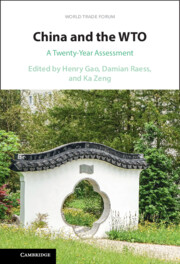Figures
6.2China’s agricultural exports by product type, 2000 and 2020
6.3China’s per capita meat consumption and income, 1961–2018
6.5China’s stocks of corn, cotton, rice, and wheat (measured in days of use)
6.6China’s Producer Support Estimate (PSE) as a percent of the value of agricultural production
9.1Patterns of coalition partners in Chinese submissions in the WTO Trade Negotiating Committee and its sub-groups (2001–2019)
9.2To what extent do you feel that China’s negotiating positions in the WTO overlap with the interests of developing countries?
9.3To what extent do you feel that Chinese negotiating positions during the Doha round were informed by historical roles that reaffirm the importance of South-South cooperation?
13.1Globalization losers and support for EU PTA vs. China PTA
13.2Support for EU PTA vs. China PTA among low-status individuals
13.3Partisan orientation and support for EU PTA vs. China PTA
15.2China has consistently generated trade surpluses this century
15.3A steady stream of WTO dispute settlement cases have been brought against China
15.4By a large margin, the United States has brought the most dispute settlement cases against China
15.5Over time a growing number of dumping and countervailing duty investigations have been initiated on products exported from China
15.6The growing shares of Chinese manufactured exports facing unilateral measures in trading partners
15.7Thirty percent of Chinese manufactured exports face three or more trade-related hurdles in foreign markets
15.8Large shares of Chinese exports faced hurdles in the U.S. market before President Trump took office
15.10The hurdles erected to Chinese exports in its own region cover proportionally less trade than those erected in the EU and the U.S.
15.11Targeting Chinese exports has become more common during the past decade
15.12Chinese goods exports are more exposed to market access curbs in trading partners than exports from other nations
19.1Chinese IIAs signed per year and cumulatively, 1982–2017
